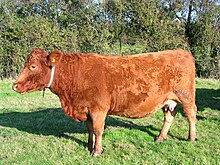The South Devon is a British breed of large beef cattle. It originated in the counties of Devon and Cornwall in south-west England, and is mentioned from the eighteenth century. It was a dual-purpose breed, kept both for its milk and for beef. Since 1972 selection has been for beef only.[4]: 303
 A cow | |
| Conservation status | |
|---|---|
| Other names |
|
| Country of origin | United Kingdom |
| Standard | South Devon Herd Book Society |
| Use |
|
| Traits | |
| Weight | |
| Height | |
| |
History
editThe South Devon originated in the counties of Devon and Cornwall in south-west England: the earliest mentions of it are from the eighteenth century.[4]: 303 How it developed is not known; one theory is that it arose from cross-breeding between local Devon stock and Channel Islands cattle such as the Alderney. Unlike other British breeds, the South Devon carries the gene for haemoglobin B, which is also present in the Channel Island breeds.[4]: 303
The South Devon Herd Book Society of England was formed, and published the first edition of the herdbook in 1891.[4]: 303
Some were exported to the United States in either 1936[5]: 714 or 1969,[4]: 303 , and then again in 1974. A breed society was formed in 1972.[6]
Characteristics
editThe South Devon is a large breed: bulls stand on average 152 cm at the withers, cows some 12 cm less.[2] The coat is curly and light red in colour; the cattle are both larger and paler than other British breeds of red cattle.[4]: 303 They may be either horned or polled; the horns are yellowish or white, and downward-curved.[7]
Use
editUntil the early part of the nineteenth century the South Devon was a triple-purpose animal, kept for its milk, for meat and for draught work.[8] Thereafter it was a dual-purpose breed, valued for its dairy qualities while the quality of the carcase was not high.[4]: 303 In the early twentieth century, the average milk yield was over 3200 kg per lactation; a good cow might give 5000 kg, and at least one reached 6200 kg. In 1974 the average lactation yield was 3390 kg, with a fat content of 4.19%; some cows exceeded 10000 kg. The conformation of the udder was not well suited to mechanical milking, and from 1972 selection was for beef only.[4]: 303
It is a large and fast-growing breed. In 1974 the average weight of bullocks at 400 days was 590 kg, with an average height at the withers of 126 cm; some animals reached more than 750 kg in that time. In the twenty-first century the daily weight gain of bullocks in the first 400 days is approximately 1.5 kg.[4]: 303
Approximately 37% of the population carries the 11-bp genetic mutation which causes bovine muscular hypertrophy (or more properly hyperplasia), which in the area of origin of the breed is known as "buffalo".[4]: 303 [9]: 221 [10] In affected animals this has the expected beneficial influence on carcase yield, and the expected detrimental effects on meat quality and on ease of calving.[9][11]
References
edit- ^ Barbara Rischkowsky, Dafydd Pilling (editors) (2007). List of breeds documented in the Global Databank for Animal Genetic Resources, annex to The State of the World's Animal Genetic Resources for Food and Agriculture. Rome: Commission on Genetic Resources for Food and Agriculture, Food and Agriculture Organization of the United Nations. ISBN 9789251057629. Archived 23 June 2020.
- ^ a b c d e f Breed data sheet: South Devon / United Kingdom of Great Britain and Northern Ireland (Cattle). Domestic Animal Diversity Information System of the Food and Agriculture Organization of the United Nations. Accessed August 2021.
- ^ Watchlist 2021–22. Kenilworth, Warwickshire: Rare Breeds Survival Trust. Archived 12 April 2021.
- ^ a b c d e f g h i j Valerie Porter, Lawrence Alderson, Stephen J.G. Hall, D. Phillip Sponenberg (2016). Mason's World Encyclopedia of Livestock Breeds and Breeding (sixth edition). Wallingford: CABI. ISBN 9781780647944.
- ^ Marleen Felius (1995). Cattle Breeds: An Encyclopedia. Doetinchem, Netherlands: Misset. ISBN 9789054390176.
- ^ History. North American South Devon Association. Accessed August 2021.
- ^ Breed Characteristics. Clyst St Mary, East Devon: South Devon Herd Book Society. Archived 20 January 2021.
- ^ History of the Breed. Clyst St Mary, East Devon: South Devon Herd Book Society. Archived 20 January 2021.
- ^ a b Pamela Wiener, Judith Alexis Smith, Alyson Margaret Lewis, John Arthur Woolliams, John Lewis Williams (2002). Muscle-related traits in cattle: the role of the myostatin gene in the South Devon breed. Genetics Selection Evolution. 34 (2): 221–232.
- ^ J.C. MacKellar (1960). The occurrence of muscular hypertrophy in South Devon cattle. Veterinary Record. 72: 507–510.
- ^ The Effect of the Double Muscling Gene in Cattle on Production Efficiency and Meat Quality - LK0653. Department for Environment, Food and Rural Affairs. Accessed August 2021.